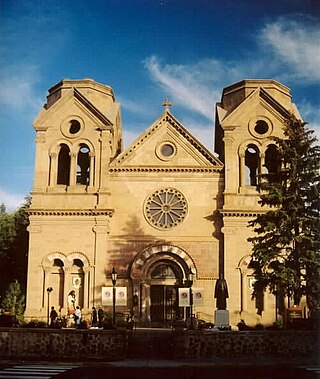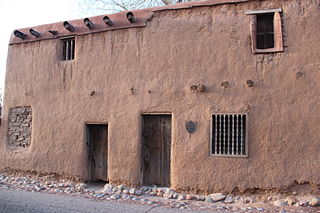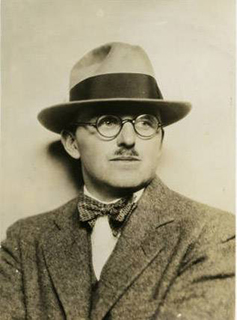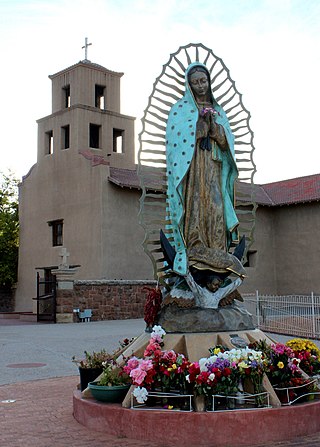
Santa Fe University of Art and Design (SFUAD) was a private for-profit art school in Santa Fe, New Mexico. The university was built from the non-profit College of Santa Fe (CSF), a Catholic facility founded as St. Michael's College in 1859, and renamed the College of Santa Fe in 1966. After financial difficulties in 2009, the college closed and the campus was purchased by the City of Santa Fe, the State of New Mexico, and Laureate Education, and reopened with a narrowed focus on film, theater, graphic design, and fine arts. As Santa Fe University of Art and Design it became a secular college of 950 students. The university closed in May 2018 due to significant ongoing financial challenges.

Jean-Baptiste Lamy, was a French-American Roman Catholic prelate who served as the first Archbishop of Santa Fe, New Mexico. Willa Cather's novel Death Comes for the Archbishop is based on his life and career.

The Archdiocese of Santa Fe is a Latin Church ecclesiastical territory or diocese of the southwestern region of the United States in the state of New Mexico. While the mother church, the Cathedral Basilica of St. Francis of Assisi, is in the city of Santa Fe, its administrative center is in the city of Albuquerque. The Diocese comprises the counties of Rio Arriba, Taos, Colfax, Union, Mora, Harding, Los Alamos, Sandoval, Santa Fe, San Miguel, Quay, Bernalillo, Valencia, Socorro, Torrance, Guadalupe, De Baca, Roosevelt, and Curry. The current archbishop is John Charles Wester, who was installed on June 4, 2015.

The New Mexico State Capitol is the seat of government of the U.S. state of New Mexico, located in its capital city of Santa Fe. It houses both chambers of the New Mexico Legislature and the offices of the Governor, Lieutenant Governor, and Secretary of State. The building is one of only eleven state capitols without a dome, and the only circular state capitol in the United States, for which it is commonly known as "the Roundhouse".

The De Vargas Street House, often referred to as the Oldest House, is a historic building in Santa Fe, New Mexico, which is often said to be one of the oldest buildings in United States. The original date of construction is unknown but the majority of the building is believed to date to the Spanish colonial period (post-1610). One archaeological study also concluded that some sections of the walls are characteristic of Pueblo architecture and may be pre-Spanish in origin. The building was listed on the National Register of Historic Places and New Mexico State Register of Cultural Properties in 1968 as a contributing property in the Barrio De Analco Historic District.

San Felipe de Neri Church is a historic Catholic church located on the north side of Old Town Plaza in Albuquerque, New Mexico. Built in 1793, it is one of the oldest surviving buildings in the city and the only building in Old Town proven to date to the Spanish colonial period. The church is listed on the New Mexico State Register of Cultural Properties and the National Register of Historic Places and has remained in continuous use for over 200 years.

The Palace of the Governors is an adobe structure built in the Territorial Style of Pueblo architecture on Palace Avenue in Santa Fe, New Mexico. Located within the Santa Fe Historic District along the Santa Fe Plaza between Lincoln and Washington avenues, it has served as the seat of government for New Mexico for centuries, having been established as the capitol building of Nuevo México in 1610.

The Cathedral Basilica of Saint Francis of Assisi, commonly known as Saint Francis Cathedral, is a Roman Catholic cathedral in downtown Santa Fe, New Mexico. It is the mother church of the Archdiocese of Santa Fe.

San Miguel Chapel, is a Spanish colonial mission church in Santa Fe, New Mexico. Originally built around 1610, it is often referred to as the oldest church in the United States. The church was rebuilt twice, once in the mid to late 17th century, and again in 1710 following the Pueblo Revolt. In both cases earlier pieces of the building may have been reused, though it is unclear to what extent. The wooden reredos, which includes a wooden statue of Saint Michael dating back to at least 1709, was added in 1798.

St. Michael's High School is a private Catholic junior/senior high school located in Santa Fe, New Mexico. It is privately run under the auspices of the international Institute of the Brothers of the Christian Schools, better known as the De La Salle Christian Brothers.

John Gaw Meem IV was an American architect based in Santa Fe, New Mexico. He is best known for his instrumental role in the development and popularization of the Pueblo Revival Style and as a proponent of architectural Regionalism in the face of international modernism. Meem is regarded as one of the most important and influential architects to have worked in New Mexico.

The Pueblo Revival style or Santa Fe style is a regional architectural style of the Southwestern United States, which draws its inspiration from Santa Fe de Nuevo México's traditional Pueblo architecture, the Spanish missions, and Territorial Style. The style developed at the beginning of the 20th century and reached its greatest popularity in the 1920s and 1930s, though it is still commonly used for new buildings. Pueblo style architecture is most prevalent in the state of New Mexico, it is often blended with the Territorial Revival architecture.

The Barrio de Analco Historic District is a National Historic Landmark District centered at the junction of East De Vargas Street and Old Santa Fe Trail in Santa Fe, New Mexico. The seven buildings of the district represent one of the oldest clusters of what were basically working-class or lower-class residences in North America, and are in a cross-section of pre-statehood architectural styles. It includes two of the oldest colonial-era buildings in the southwest, the San Miguel Mission church (1710), and the "Oldest House", built in 1620 and now a museum. The district was declared a National Historic Landmark in 1968.

Seton Village is a National Historic Landmark District in a rural residential area south of Santa Fe in Santa Fe County, New Mexico, United States. It encompasses a residential settlement and educational facility established in 1930 by Ernest Thompson Seton (1860-1946), an educator and conservationist best known as a founder of the Boy Scouts of America. The district includes the remains of Seton's 32-room home and other residential and educational buildings constructed mostly between 1930 and 1945. It was declared a National Historic Landmark in 1965.

Santa Fe is the capital of the U.S. state of New Mexico. The name "Santa Fe" means 'Holy Faith' in Spanish, and the city's full name as founded remains La Villa Real de la Santa Fé de San Francisco de Asís.

Territorial Revival architecture describes the style of architecture developed in the U.S. state of New Mexico in the 1930s. It derived from New Mexico vernacular Territorial Style, an original style from Santa Fe de Nuevo México following the founding of Albuquerque in 1706. Territorial Revival incorporated elements of traditional regional building techniques with higher style elements. The style was intended to recall the Territorial Style and was extensively employed for New Mexico state government buildings in Santa Fe.

Territorial Style was an architectural style of building developed and used in Santa Fe de Nuevo México, popularized after the founding of Albuquerque in 1706. Reintroduced during the New Mexico Territory from the time of the Mexican and American territorial phases in 1821 until 1912, at which time New Mexico stopped being a territory and became a US state. Following the increase of its popularity in the 1930s and 1940s, it became referred to as the Territorial Revival style, which became another popular building style alongside New Mexico's Pueblo Revival style.

The Reredos of Our Lady of Light is a historic stone reredos carved in 1761 in Santa Fe, New Mexico. It was originally installed in the Chapel of Our Lady of Light on the Plaza and is presently housed in Cristo Rey Church, which was built for that purpose in 1940. Described as "the only one of its kind from the Spanish period in the United States" and "definitely one of the most extraordinary pieces of ecclesiastical art in the country", it was added to the National Register of Historic Places in 1970.

Hodgin Hall, previously known at various times as the University Building, Main Building, or Administration Building, is a historic building on the University of New Mexico campus in Albuquerque, New Mexico. Completed in 1892, it was the first building constructed on the UNM campus and the university's only building for almost a decade. The building was originally designed by Jesse Wheelock in the Richardsonian Romanesque style, but structural problems with the building's roof gave university president William Tight the opportunity to have it remodeled in his preferred Pueblo Revival style in 1908.

The Santuario de Nuestra Señora de Guadalupe is a historic Catholic shrine in Santa Fe, New Mexico. It is the oldest church in the United States dedicated to Our Lady of Guadalupe and is listed on the New Mexico State Register of Cultural Properties. It is also a contributing property in the Santa Fe Historic District.






















